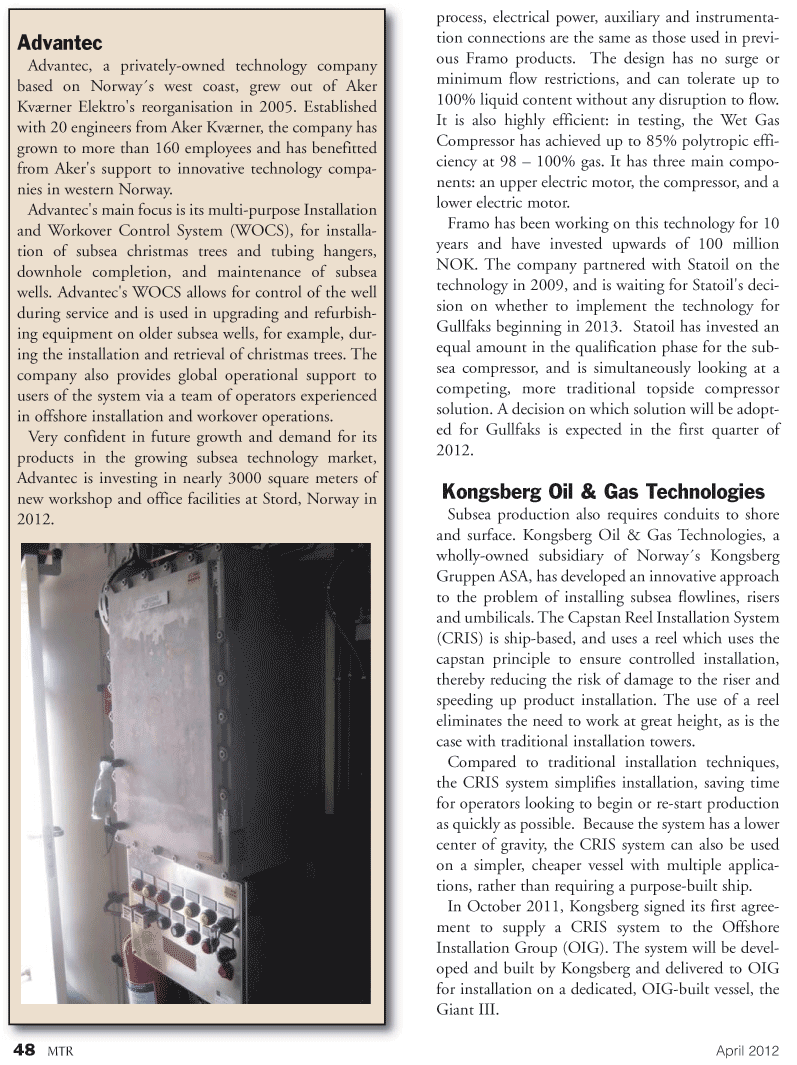
Page 48: of Marine Technology Magazine (April 2012)
Global Offshore Deepwater Report
Read this page in Pdf, Flash or Html5 edition of April 2012 Marine Technology Magazine
48MTRApril 2012process, electrical power, auxiliary and instrumenta- tion connections are the same as those used in previ- ous Framo products. The design has no surge or minimum flow restrictions, and can tolerate up to 100% liquid content without any disruption to flow. It is also highly efficient: in testing, the Wet Gas Compressor has achieved up to 85% polytropic effi- ciency at 98 ? 100% gas. It has three main compo- nents: an upper electric motor, the compressor, and a lower electric motor. Framo has been working on this technology for 10 years and have invested upwards of 100 million NOK. The company partnered with Statoil on the technology in 2009, and is waiting for Statoil's deci- sion on whether to implement the technology forGullfaks beginning in 2013. Statoil has invested an equal amount in the qualification phase for the sub-sea compressor, and is simultaneously looking at a competing, more traditional topside compressor solution. A decision on which solution will be adopt-ed for Gullfaks is expected in the first quarter of 2012.Kongsberg Oil & Gas Technologies Subsea production also requires conduits to shore and surface. Kongsberg Oil & Gas Technologies, a wholly-owned subsidiary of Norway´s Kongsberg Gruppen ASA, has developed an innovative approach to the problem of installing subsea flowlines, risers and umbilicals. The Capstan Reel Installation System (CRIS) is ship-based, and uses a reel which uses the capstan principle to ensure controlled installation, thereby reducing the risk of damage to the riser and speeding up product installation. The use of a reel eliminates the need to work at great height, as is the case with traditional installation towers. Compared to traditional installation techniques, the CRIS system simplifies installation, saving timefor operators looking to begin or re-start production as quickly as possible. Because the system has a lower center of gravity, the CRIS system can also be used on a simpler, cheaper vessel with multiple applica- tions, rather than requiring a purpose-built ship. In October 2011, Kongsberg signed its first agree- ment to supply a CRIS system to the Offshore Installation Group (OIG). The system will be devel- oped and built by Kongsberg and delivered to OIG for installation on a dedicated, OIG-built vessel, the Giant III. AdvantecAdvantec, a privately-owned technology company based on Norway´s west coast, grew out of Aker Kværner Elektro's reorganisation in 2005. Established with 20 engineers from Aker Kværner, the company has grown to more than 160 employees and has benefitted from Aker's support to innovative technology compa- nies in western Norway. Advantec's main focus is its multi-purpose Installation and Workover Control System (WOCS), for installa- tion of subsea christmas trees and tubing hangers, downhole completion, and maintenance of subsea wells. Advantec's WOCS allows for control of the well during service and is used in upgrading and refurbish- ing equipment on older subsea wells, for example, dur- ing the installation and retrieval of christmas trees. The company also provides global operational support to users of the system via a team of operators experiencedin offshore installation and workover operations. Very confident in future growth and demand for its products in the growing subsea technology market, Advantec is investing in nearly 3000 square meters of new workshop and office facilities at Stord, Norway in 2012.

 47
47

 49
49
